Scientist-soft Matter Scientist Beyond Meat 4 Reviews - El Segundo Ca
"This is our E-tongue," explains Parker Lee, pb scientist of Beyond Meat's analytical lab.
The young scientist stands by a sleek, 2-foot compactor that squishes Across Meat'due south burgers to exam for chewiness, juiciness, and elasticity. A mechanical arm increases and decreases pressure to examine whether the mouthfeel replicates what you might experience at, say, an In-North-Out.
With each lever, the institute-based not-meat patty oozes–so bursts with claret orange-colored juice. The question: Can they further delay the bursts? Or brand the texture a bit softer, without expensing firmness?
"Nosotros're always trying to improve our products," says Lee equally he swaps in a fresh patty to meet its fate in the E-tongue.
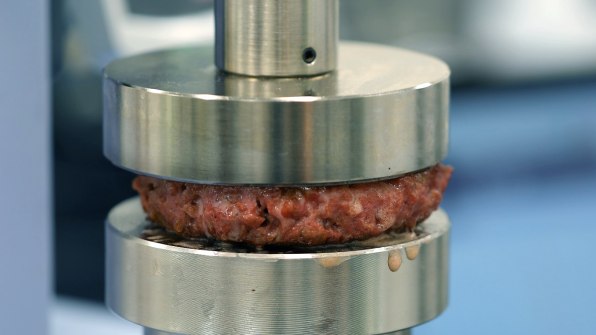
I am getting an exclusive look at the updated Beyond Meat R&D lab in El Segundo, California. Here, dozens of scientists don white coats stitched with "The future of protein" logos. The 26,000-foursquare foot facility features every machine, gadget, and gizmo dedicated to solving one question: How can we mimic meat? And more importantly, how do we brand it expect, experience, and taste similar the real thing?
Across Meat is no longer the pocket-sized startup competing against the apprehensive blackness bean burger. The plant-based meat substitute maker has sold thirteen million burgers since its 2016 debut and just concluding week admitted it is having trouble meeting demand afterward multiple Whole Foods stores ran out. Besides the marketplace concatenation, Beyond Meat sells at Amazon Fresh and 20,000 other grocery retailers–as well equally 10,000 restaurants, hotels, and universities.
Several cultural trends led to Across Meat's success, but so has its commitment to tweaking its collection of prepare-to-cook products. And then, it makes sense the brand would need a space to accomplish its ultimate purpose–namely, to get even meatier.
The entire El Segundo operation dedicates itself to season, aroma, appearance, and texture. Every day, a squad of scientists substantially share one job: to discover how ingredients such equally peas or fava beans can get an alternative to cows and other animals.
"Everything here is an investment toward that goal of making it indistinguishable," says founder and CEO Ethan Chocolate-brown.
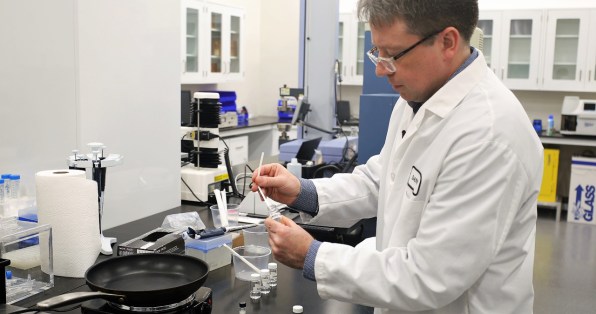
The 'meat' machines
Lee, a macromolecular scientist, previously fabricated medical devices for cancer patients–today, he uses his scientific background to supercede animate being cartilage with garden produce. This is no way strikes him as strange. "It'due south all science," he says.
The aforementioned goes for Jonny Gordon, Across Meat'due south color lab scientist. A pharmacist with no prior food science experience, he now runs a research facility whose sole job is to ameliorate the color of substitute meat.
His lab coat splashed with beet stains, he plays with a variety of fruits and vegetables–blending them together in a more sci-fi version of a Vitamix. The contents are so powderized in what looks like a cotton candy machine. This despite the brand's patties already exhibiting a very realistic pink. Information technology even turns brown during the cooking process.
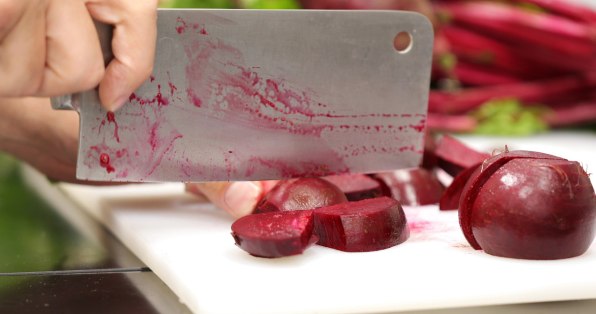
After during my facility bout, Daniel Ryan, Beyond Meat'southward director of chemistry, works with the "Eastward-nose" odor inspector. The machine isolates more than 1,000 molecules in animate being and constitute matter to cistron which contribute to smell and taste. It doesn't sample meat, rather the air that surrounds pieces of meat inside tiny vials.
Ryan then tries to match it to molecules like in the establish kingdom, everything from parsley to fennel. He handles tiny drinking glass bottles marked with descriptions like "meaty," "gamey," "roasted," and "fat." The goal? Recreate the exact sensory experience of a archetype steakhouse. "Information technology's a continuous process," says Ryan, calculation, "a lifetime'due south work."
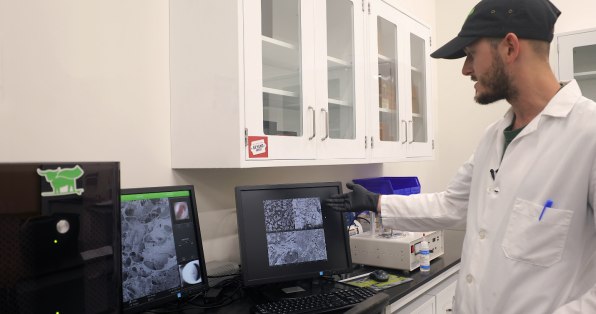
Brown credits the research team's unique mishmash of backgrounds–biochemistry, biophysics, plant science, wellness intendance, tech, and chemistry–to the nine-year-old company's success. In fact, the founder didn't particularly seek out food science evolution experts. Innovation, says Brown, is best served past scientific diversity.
"We needed to invest in scientific discipline technology to fundamentally understand meat–its composition and compages and to rebuild it from plants," says Dark-brown. The old organisation wasn't going to cut information technology: "We expect a bunch of chefs and food scientists to solve a massive global problem, which is supplying protein to seven billion people."
The Manhattan Embankment Projection
With that came the demand to expand its R&D, at which point Beyond Burgers took over an erstwhile airport hangar in El Segundo, ten times the size of its previous lab space. Information technology was dubbed "The Manhattan Beach Project" in reference to its location (it's nearly SoCal's Manhattan Embankment) and the WWII atomic bomb research. (Brown is a "big fan" of Richard Rhodes's Pulitzer prize-winning volume The Making of the Atomic Bomb.)
Chocolate-brown sees the facility gathering a group of scientists, engineers, and researchers for a very clear goal: to salve humanity from its destructive animal consumption. A study by the Environmental Working Group (EWG) found that red meat production releases 10 to 40 times every bit many greenhouse gas emissions as mutual vegetables and grains.
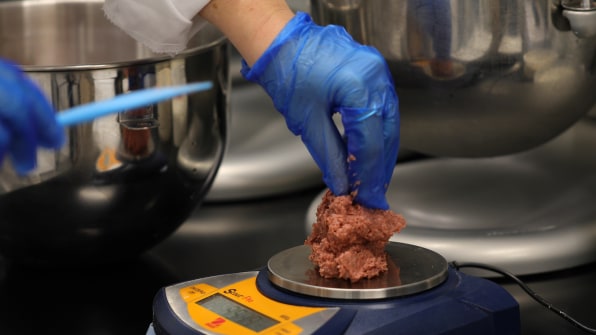
Beyond Meat constantly tweaks its bestselling burger–the brand plans to soon release its third iteration. Brownish wants newer versions each twelvemonth because he thinks it tin can always be more meat-like–and may keep competitors at bay.
But like Coca-Cola'due south new-formula fiasco, are in that location drawbacks of changing a recipe that'due south already amassed millions of fans? The El Segundo quarters feature a "sensory lab" for blind-tasting capabilities. The controlled environment blocks out scent, noise, basically anything that might distract an eater.
Testers don't necessarily hold the final call. When readying the latest version, results showed they preferred the original burger. Brown is pushing ahead regardless considering "it'southward meliorate," he says, "by any reasonable standards. I'm convinced something went wrong with the test."
Abiding tweaking isn't elementary for a company that refuses to contain gluten or GMOs, which competitors like the Impossible Burger rely on. "We make our scientists' lives very difficult," concedes Dark-brown.
Across Meat refuses the controversial ingredients because it wants to position itself equally a good for you food company, ane that consumers tin feel comfortable consuming iii times a mean solar day. It promotes its healthier leanings first and foremost in its ad campaigns. Among its global ambassadors are athletes from the NBA, WNBA, MLB, and Globe Surf League. Several years ago, it hired Jeff Manning, the acclaimed architect of the iconic "Got Milk?" campaign.
"Can nosotros market it in a way that makes it absurd to eat our products, versus an obligation," says Dark-brown.
Not that it'due south a difficult sell: Consumer demand for transparency quickly transformed the food industry, with 75% of shoppers now examining products prior to purchase, according to a study past Label Insight. Overall, Americans increasingly await to incorporate wellness: Nielsen reports that 88% of consumers volition pay more for healthier foods.
Beyond Meat is keenly enlightened of that. When the make was readying its sausage variety for market this past spring, it debated betwixt three unlike versions, with the team tempted to get with the fattiest–and presumably tastiest–pick. Ultimately, the healthier version was crowned the victor.
As well health concerns, Chocolate-brown believes consumers are now also factoring how their food choices contribute to the industrial farming system and impact the environs.
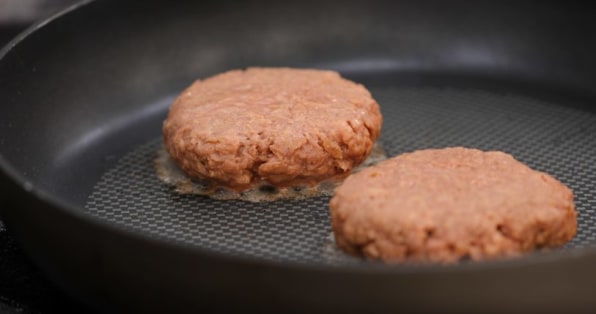
"More than and more consumers are beginning to understand the biggest pick they make in terms of impact on the climate is protein," says Brownish. A recent poll institute that 43% of consumers more likely to try plant-based alternatives today than only five years agone.
It takes an estimated eighteen,000 gallons of water to produce one pound of beef. (Peas, in comparison, take 740 gallons.) Factor in the time it takes for an brute to grow musculus, and plants seem like a far more than efficient supply chain.
Then there's the economic statement: Brown is confident that in several years, plant-based alternatives volition cost less than meat. A pack of Across Meat ranges from just in a higher place $5 on Amazon Fresh to $7.49 in grocery stores for two four-ounce patties, which can be virtually double the price of beefiness per ounce in some markets. Its products will become more affordable every bit it masters processes and manufacturing, whereas beefiness and poultry is projected to become more expensive, according to the Section of Agriculture Economic Research Service. (The Manhattan Beach Project is projected to aid the visitor cut product time in one-half.)
Only Across Meat'south messaging doesn't strive to make yous feel guilty about your electric current nutrition choices; information technology's more virtually making something so proficient and then tasty that, every bit Brownish hopes, "they desire information technology."
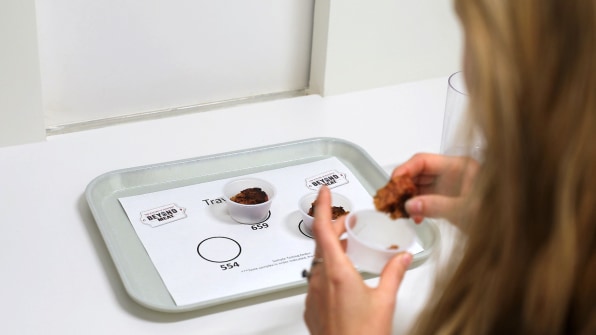
A plentiful plant-based future
The Beyond Meat founder'south role is a minimalist, sparsely decorated space with photos of Ethan Brown's family in 1 corner, a surfboard hanging in another. I chemical element that caught my center: the multiple framed printing quotes doubting the meatless juggernaut.
"Slightly ameliorate tofurkey," reads one. "Companies similar Beyond Meat will never be able to introduce pea protein powder into one end of a machine and extrude a disarming substitute for seared steak or roasted chicken from the other," reads another.
Beyond Meat certainly defied market expectations and early naysayers. It no longer competes solely in the meat culling category. The global meat substitutes market is expected to attain $half dozen.4 billion by 2023, co-ordinate to ResearchAndMarkets.com. Even KFC is experimenting with vegetarian fried "chicken."
The visitor, which has raised $72 million in funding to date, has more work to practise to overcome the Tofurkey-tainted stigma, Brown says. To that end, an aggressive range of products are in the pipeline, from domicile cooked essentials to snacky favorites, every bit is more than plant-based poultry, pork, and likely bacon substitutes. (The latter is a toughie since it's hard to get the fat to lie just right.)
Brown is adamant that his R&D team volition crack the code of all your barbecue and restaurant favorites, no matter how daunting–including the Holy Grail: "The ambition is to go all the way up to steak."
Source: https://www.fastcompany.com/90202590/exclusive-inside-beyond-meats-innovative-future-food-lab
0 Response to "Scientist-soft Matter Scientist Beyond Meat 4 Reviews - El Segundo Ca"
Post a Comment